Ken Pathak
KARMA: Efficient Structural Defect Segmentation via Kolmogorov-Arnold Representation Learning
Aug 11, 2025Abstract:Semantic segmentation of structural defects in civil infrastructure remains challenging due to variable defect appearances, harsh imaging conditions, and significant class imbalance. Current deep learning methods, despite their effectiveness, typically require millions of parameters, rendering them impractical for real-time inspection systems. We introduce KARMA (Kolmogorov-Arnold Representation Mapping Architecture), a highly efficient semantic segmentation framework that models complex defect patterns through compositions of one-dimensional functions rather than conventional convolutions. KARMA features three technical innovations: (1) a parameter-efficient Tiny Kolmogorov-Arnold Network (TiKAN) module leveraging low-rank factorization for KAN-based feature transformation; (2) an optimized feature pyramid structure with separable convolutions for multi-scale defect analysis; and (3) a static-dynamic prototype mechanism that enhances feature representation for imbalanced classes. Extensive experiments on benchmark infrastructure inspection datasets demonstrate that KARMA achieves competitive or superior mean IoU performance compared to state-of-the-art approaches, while using significantly fewer parameters (0.959M vs. 31.04M, a 97% reduction). Operating at 0.264 GFLOPS, KARMA maintains inference speeds suitable for real-time deployment, enabling practical automated infrastructure inspection systems without compromising accuracy. The source code can be accessed at the following URL: https://github.com/faeyelab/karma.
Physics-Informed Neural Network Surrogate Models for River Stage Prediction
Mar 21, 2025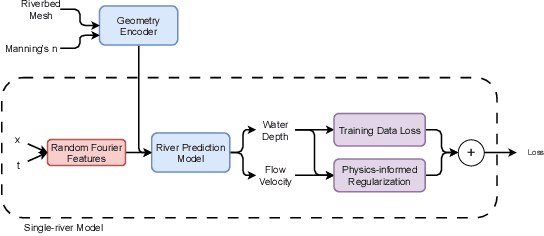
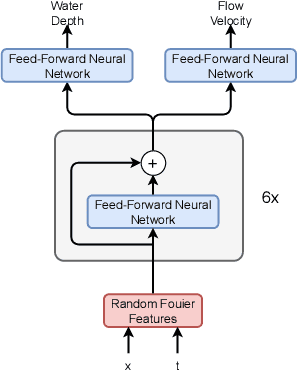
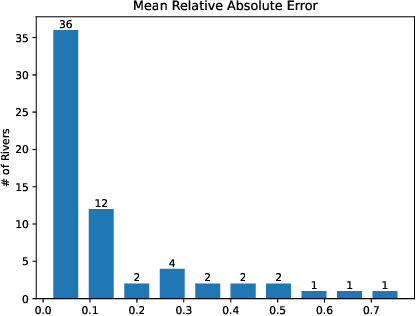
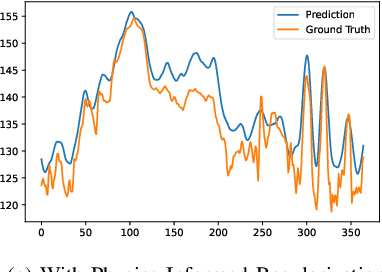
Abstract:This work investigates the feasibility of using Physics-Informed Neural Networks (PINNs) as surrogate models for river stage prediction, aiming to reduce computational cost while maintaining predictive accuracy. Our primary contribution demonstrates that PINNs can successfully approximate HEC-RAS numerical solutions when trained on a single river, achieving strong predictive accuracy with generally low relative errors, though some river segments exhibit higher deviations. By integrating the governing Saint-Venant equations into the learning process, the proposed PINN-based surrogate model enforces physical consistency and significantly improves computational efficiency compared to HEC-RAS. We evaluate the model's performance in terms of accuracy and computational speed, demonstrating that it closely approximates HEC-RAS predictions while enabling real-time inference. These results highlight the potential of PINNs as effective surrogate models for single-river hydrodynamics, offering a promising alternative for computationally efficient river stage forecasting. Future work will explore techniques to enhance PINN training stability and robustness across a more generalized multi-river model.
KANICE: Kolmogorov-Arnold Networks with Interactive Convolutional Elements
Oct 22, 2024


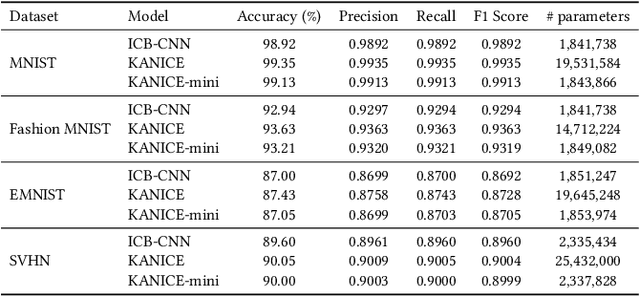
Abstract:We introduce KANICE (Kolmogorov-Arnold Networks with Interactive Convolutional Elements), a novel neural architecture that combines Convolutional Neural Networks (CNNs) with Kolmogorov-Arnold Network (KAN) principles. KANICE integrates Interactive Convolutional Blocks (ICBs) and KAN linear layers into a CNN framework. This leverages KANs' universal approximation capabilities and ICBs' adaptive feature learning. KANICE captures complex, non-linear data relationships while enabling dynamic, context-dependent feature extraction based on the Kolmogorov-Arnold representation theorem. We evaluated KANICE on four datasets: MNIST, Fashion-MNIST, EMNIST, and SVHN, comparing it against standard CNNs, CNN-KAN hybrids, and ICB variants. KANICE consistently outperformed baseline models, achieving 99.35% accuracy on MNIST and 90.05% on the SVHN dataset. Furthermore, we introduce KANICE-mini, a compact variant designed for efficiency. A comprehensive ablation study demonstrates that KANICE-mini achieves comparable performance to KANICE with significantly fewer parameters. KANICE-mini reached 90.00% accuracy on SVHN with 2,337,828 parameters, compared to KANICE's 25,432,000. This study highlights the potential of KAN-based architectures in balancing performance and computational efficiency in image classification tasks. Our work contributes to research in adaptive neural networks, integrates mathematical theorems into deep learning architectures, and explores the trade-offs between model complexity and performance, advancing computer vision and pattern recognition. The source code for this paper is publicly accessible through our GitHub repository (https://github.com/m-ferdaus/kanice).
Imbalance-Aware Culvert-Sewer Defect Segmentation Using an Enhanced Feature Pyramid Network
Aug 19, 2024



Abstract:Imbalanced datasets are a significant challenge in real-world scenarios. They lead to models that underperform on underrepresented classes, which is a critical issue in infrastructure inspection. This paper introduces the Enhanced Feature Pyramid Network (E-FPN), a deep learning model for the semantic segmentation of culverts and sewer pipes within imbalanced datasets. The E-FPN incorporates architectural innovations like sparsely connected blocks and depth-wise separable convolutions to improve feature extraction and handle object variations. To address dataset imbalance, the model employs strategies like class decomposition and data augmentation. Experimental results on the culvert-sewer defects dataset and a benchmark aerial semantic segmentation drone dataset show that the E-FPN outperforms state-of-the-art methods, achieving an average Intersection over Union (IoU) improvement of 13.8% and 27.2%, respectively. Additionally, class decomposition and data augmentation together boost the model's performance by approximately 6.9% IoU. The proposed E-FPN presents a promising solution for enhancing object segmentation in challenging, multi-class real-world datasets, with potential applications extending beyond culvert-sewer defect detection.
SHARP-Net: A Refined Pyramid Network for Deficiency Segmentation in Culverts and Sewer Pipes
Aug 02, 2024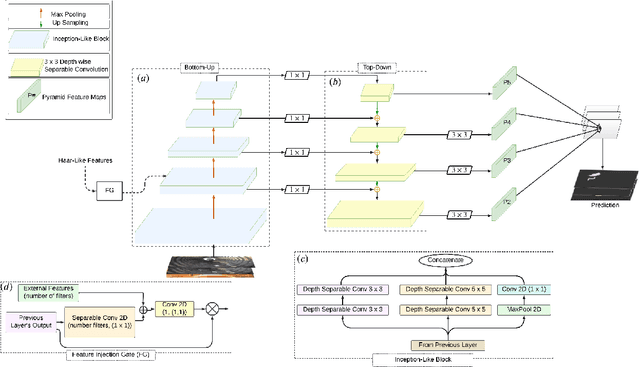
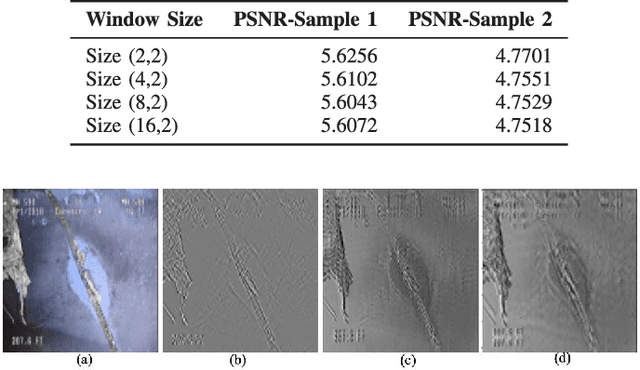
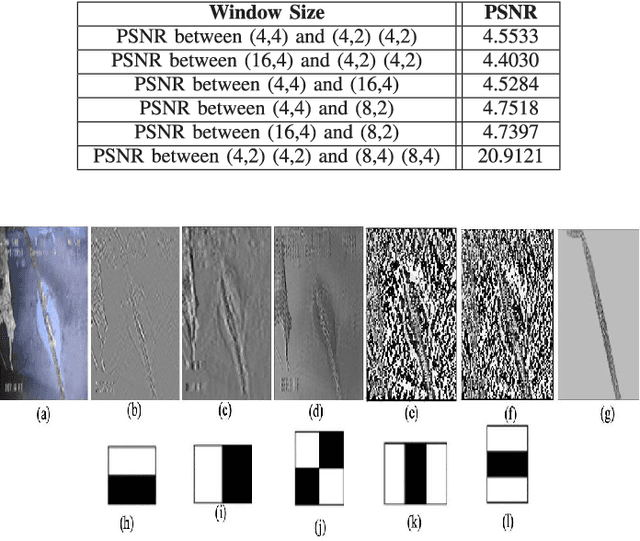
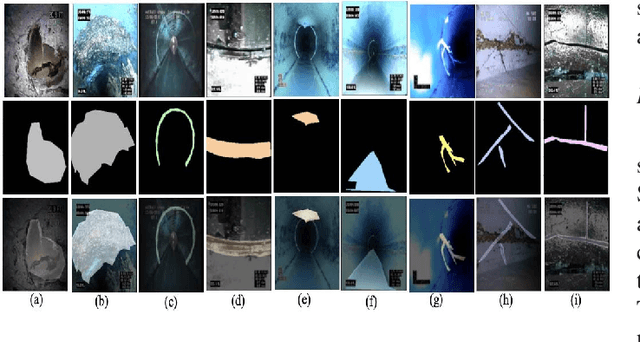
Abstract:This paper introduces Semantic Haar-Adaptive Refined Pyramid Network (SHARP-Net), a novel architecture for semantic segmentation. SHARP-Net integrates a bottom-up pathway featuring Inception-like blocks with varying filter sizes (3x3$ and 5x5), parallel max-pooling, and additional spatial detection layers. This design captures multi-scale features and fine structural details. Throughout the network, depth-wise separable convolutions are used to reduce complexity. The top-down pathway of SHARP-Net focuses on generating high-resolution features through upsampling and information fusion using $1\times1$ and $3\times3$ depth-wise separable convolutions. We evaluated our model using our developed challenging Culvert-Sewer Defects dataset and the benchmark DeepGlobe Land Cover dataset. Our experimental evaluation demonstrated the base model's (excluding Haar-like features) effectiveness in handling irregular defect shapes, occlusions, and class imbalances. It outperformed state-of-the-art methods, including U-Net, CBAM U-Net, ASCU-Net, FPN, and SegFormer, achieving average improvements of 14.4% and 12.1% on the Culvert-Sewer Defects and DeepGlobe Land Cover datasets, respectively, with IoU scores of 77.2% and 70.6%. Additionally, the training time was reduced. Furthermore, the integration of carefully selected and fine-tuned Haar-like features enhanced the performance of deep learning models by at least 20%. The proposed SHARP-Net, incorporating Haar-like features, achieved an impressive IoU of 94.75%, representing a 22.74% improvement over the base model. These features were also applied to other deep learning models, showing a 35.0% improvement, proving their versatility and effectiveness. SHARP-Net thus provides a powerful and efficient solution for accurate semantic segmentation in challenging real-world scenarios.
 Add to Chrome
Add to Chrome Add to Firefox
Add to Firefox Add to Edge
Add to Edge